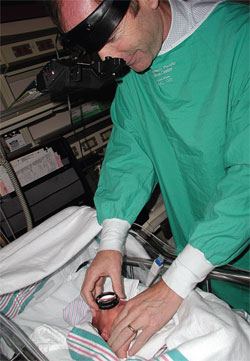 |
| Treatment via laser photocoagulation is the most common choice for ROP patients, study finds. Click image to enlarge. |
In a recent retrospective study of 184,750 premature infants and 31,606 infants at increased risk for retinopathy of prematurity (ROP) identified over an 18-year period, disease incidence was 2.6 cases/1000 for premature and 15.2 cases/1000 for high-risk infants.1 Laser photocoagulation was the most common treatment, though the majority (72.4%) of combination patients received anti-VEGF prior to laser.
“Overall, 4.5% of premature infants and 26.5% of high-risk premature infants developed ROP, with 5.7% of ROP patients receiving treatment,” the study authors wrote in a paper for the Ophthalmology journal.
The study period of 2003 to 2020 began when anti-VEGF drugs were not available. Their use in the last decade led to a decline in laser use but photocoagulation remained the mainstay.
For ROP patients, laser treatment (80.7% of cases) was more common than either anti-VEGF monotherapy (13.3%) or combination therapy (5.9%). Male and female infants were treated with laser at similar rates (49.2% vs 50.8%) but females were less likely to receive anti-VEGF vs laser monotherapy (OR 0.57). Extremely low birth weight (<1000g) was not correlated with anti-VEGF usage vs. laser (OR 1.08).
In an economic analysis of interventions to screen, treat and manage ROP, researchers recently performed a systematic literature review that found that cost-effectiveness analysis was the most common economic evaluation.2 The work was published in Ophthalmic Epidemiology.
Telemedicine was the most discussed screening technique, followed by indirect ophthalmoscopy, according to the study authors. The findings suggest that telemedicine screening is highly cost-effective for retinopathy of prematurity patients.
Additionally, the researchers found that among the papers that discussed screening guidelines, birth weight and gestational age at birth were the most evaluated screening criteria. However, they reported that the most cost-effective strategy was to routinely screen only infants weighing 1,200g at birth or less.
“Retinopathy of prematurity screening and treatment strategies reviewed were highly cost-effective,” the study authors concluded. “This review may assist eye health policymakers in planning nationwide screening and treatment programs to combat vision loss and blindness due to retinopathy of prematurity.”
1. Khan SI, Ryu WY, Wood EH. Retinopathy of prematurity treatment trends from 2003-2020 in the United States. Ophthalmol. June 14, 2022 [Epub ahead of print] 2. Smith AF, Sadeq A, Kinzel E, et al. A systematic review of economic evaluations conducted for interventions to screen, treat, and manage retinopathy of prematurity (ROP) in the United States, United Kingdom, and Canada. Ophthalmic Epidemiol. June 14, 2022. [Epub ahead of print]. |

